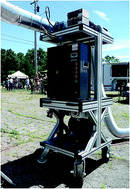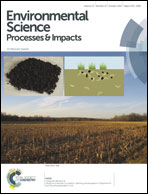Ultrafine and respirable particle exposure during vehicle fire suppression
Abstract
Vehicle fires are a common occurrence, yet few studies have reported exposures associated with burning vehicles. This article presents an assessment of firefighters' potential for ultrafine and respirable particle exposure during vehicle fire suppression training. Fires were initiated within the engine compartment and passenger cabins of three salvaged vehicles, with subsequent water suppression by fire crews. Firefighter exposures were monitored with an array of direct reading particle and air quality instruments. A flexible metallic duct and blower drew contaminants to the instrument array, positioned at a safe distance from the burning vehicles, with the duct inlet positioned at the nozzle operator's shoulder. The instruments measured the particle number, active surface area, respirable particle mass, photoelectric response, aerodynamic particle size distributions, and air quality parameters. Although vehicle fires were suppressed quickly (<10 minutes), firefighters may be exposed to short duration, high particle concentration episodes during fire suppression, which are orders of magnitude greater than the ambient background concentration. A maximum transient particle concentration of 1.21 × 107 particles per cm3, 170 mg m−3 respirable particle mass, 4700 μm2 cm−3 active surface area and 1400 (arbitrary units) in photoelectric response were attained throughout the series of six fires. Expressed as fifteen minute time-weighted averages, engine compartment fires averaged 5.4 × 104 particles per cm3, 0.36 mg m−3 respirable particle mass, 92 μm2 cm−3 active particle surface area and 29 (arbitrary units) in photoelectric response. Similarly, passenger cabin fires averaged 2.04 × 105 particles per cm3, 2.7 mg m−3 respirable particle mass, 320 μm2 cm−3 active particle surface area, and 34 (arbitrary units) in photoelectric response. Passenger cabin fires were a greater potential source of exposure than engine compartment fires. The wind direction and the relative position of the fire crew to the stationary burning vehicle played a primary role in fire crews' potential for exposure. We recommend that firefighters wear self-contained breathing apparatus during all phases of the vehicle fire response to significantly reduce their potential for particulate, vapor, and gaseous exposures.


 Please wait while we load your content...
Please wait while we load your content...